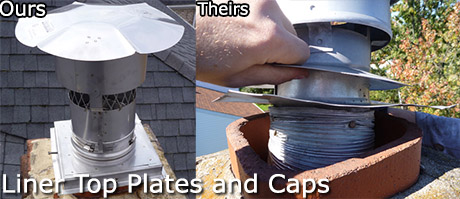
Liner Cap Solutions
When a stainless steel liner is installed it should be secure at both the top and
the bottom. Very often other companies that install liners use what are
called flat top plates on a terracotta tile and then add caulk to create a
seal. The problem with this is that there are no screws holding everything
in place and very often we have to repair this area.
When wind, rain, and the heat of the flue combine together the caulk often
loosens and creates a gap in the system where there should not be one. The
fix is fairly straight forward with us removing the old top connection and cap
if need be with a proper top plate that is either drilled and anchored or
screwed on.
Three Stainless Steel Cap Upgrades (Click image to enlarge)
Lifetime Blow-off Guarantee
All of our caps come with a lifetime corrosion and blow-off guarantee. If it blows off for any reason and is
still salvageable, we will put it back on no questions asked. If it is damaged from the fall and it is not usable, we will replace it with a new cap free of charge.*
If you live in a particularly high wind area please
ask about our wind directional caps--please see specialty
caps to look at our wind directional cobra caps.
*NOTE: Caps purchased from us and installed by the customer do not carry this warranty.
Schedule An Installation
To schedule a top plate and cap installation or other repair please visit our contact page
and we will respond as soon as possible to set up a date with you. We also offer a fully documented visit
stating the health of your system via a $99 Level 1 Inspection to determine the health of your system.
Reasons To Have a Cap
There are many reasons to have a cap on your chimney. The two primary reasons are to keep rain water out while also
keeping pests out like birds, squirrels, and raccoons. A customer even told us that once a hawk entered in his chimney and almost
came into his house when he opened the damper--never something you want to happen.
Let's address these reasons in a little more depth--first, by preventing water from entering the chimney you are extending the life of the flue and masonry both visible and hidden.
Although wood is not as corrosive as oil, coal, nor high-efficiency gas furnaces, it's exhaust mixture has been chemically analyzed to contain 67 different combustible gases. Many of these are corrosive when they are not burned and condense out within the flue system.
Oil is very corrosive
along with producing additional condensation. We have found that on average after a period of 40-60
years the surface of a tile lined oil flue becomes very unsafe due to moisture mixing with oil exhaust gases causing severe deterioration
of the tile.
Flaking of the tile can lead to cracks, cracks can lead to chunks of tile, and those then can fall and create a blockage at the base of your flue. This can become
a serious problem over night. See more of what can happen and how to prevent these scenarios in the stainless steel liner portion of our site.
Keeping animals out is of course a no-brainer but here is another scenario to consider: When you do not have a chimney cap (or have a poorly designed cap) and are heating your home
in the winter your oil/gas furnace or stove is producing carbon monoxide and heat.
Birds are often drawn to the warmth of the chimney and will perch on top of it
but the poisonous gas will knock them out which leads to them falling down the flue creating a blockage. That same carbon monoxide will start making its way back
into your home creating a very serious and potentially deadly situation for you and your family.